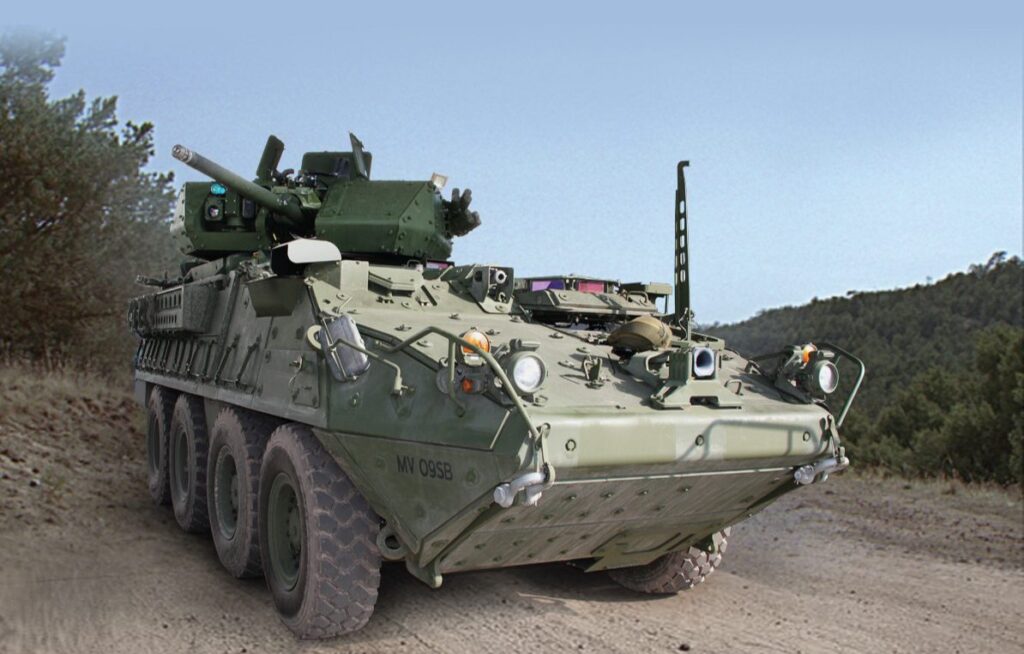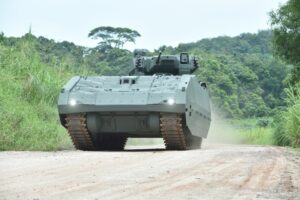UPDATED with expert comment AUSA: After 15 years of cancellations and delays, the US Army is pushing through some vital upgrades for its armored vehicles. Service leaders recently ordered sweeping reforms to speed up acquisition, but the Program Executive Office for Ground Combat Systems has already started accelerating.
The upgunned Stryker, the Trophy anti-missile system, and, if Chief of Staff Mark Milley gets his way, the Mobile Protected Firepower light tank should move from idea to reality in about four years apiece. That’s a stark contrast to a generation of cancelled programs that tried to develop new war machines from scratch: the Crusader howitzer, Future Combat Systems, and Ground Combat Vehicle. All were cancelled before fielding a single system.
So what changed? Three things: the new urgency of the Russian threat, a new self-restraint in the Army’s appetite for high tech, and – most out of character for the Army – a new willingness to take certain kinds of risk. That includes bypassing the laborious requirements process and even truncating some testing.

Maj. Gen. David Bassett
“In the past. … we would have started off with a requirement that would have been written without constraint, (e.g.) a perfect APS,” Maj. Gen. David Bassett, the head of PEO-GCS, told the Association of the US Army conference here. When the hardware was built, he went on, “we would test every line-replaceable unit for things like dust and humidity, dust, cold, and heat.” With these efforts, he said, they limited both appetites and testing in the interest of speed: “That does require some willingness to accept a system that’s not 100 percent.”
UPDATED 100 percent solutions sound good in theory, but in practice they drove the Army to programs that cost too much, weighed too much, or required too much untested technology. The priority now is very different, focusing on what can get to soldiers ASAP, one well-connected analyst told me: “Gen. Milley’s question is, ‘what is the best I can get by 2020-2025’? Immediate, capacity-driven schedule is significantly more important than long-duration or high-risk (technology).”
UPDATE This more incremental approach makes sense given the progress of the underlying technology, said Atlantic Council fellow and industry analyst Jim Hasik. Combat vehicles aren’t microchips, they don’t double in capacity every 18 months

James Hasik
UPDATE “Improvements in automotive technologies, whether suspensions or engines, has been modest,” Hasik told me. “We’ve had no breakthroughs in passive protection” — the last big change was Chobham composite armor in the 1980s — “so the tradeoff amongst armor, payload, weight is still what it has long been. We’ve been talking about active protection for many years, and the Israelis have of late shown real success; that’s the closest thing to a revolution in ground combat. On every other front, advance has been incremental. (In hindsight), programs like FCS and GCV” — which sought revolutionary change — “were doomed before they were begun.”
Is this working? “There are signs of life in Army acquisition,” summed up Andrew Hunter, a former Hill and Pentagon staffer, citing the Stryker program in particular. “Under the radar screen, there has been a lot of excellence in Army acquisition all along,….and we saw that in Iraq and Afghanistan with all the stuff that was fielded,” he said. It wasn’t the work of the program offices at the tactical level that went wrong, Hunter said, but the strategic decisions on big, ambitious 100-percent-solution programs — above all, FCS — that led to “a lost generation of modernization.”

Andrew Hunter
That cloud still hangs heavy over the Army’s reputation on Capitol Hill, Hunter said: “I think the key is in explaining how (the new strategy) does not repeat the mistakes of Future Combat System.”
UPDATED “The Army has had modest and significant successes recently on ground vehicle programs,” said a former Hill staffer, and not just in PEO-GCS: The Joint Light Tactical Vehicle to replace the Humvee is also progressing well. “Has the Army turned the corner? No. Is it on its way? Yes. MPF (Mobile Protected Firepower) will be the true test of Army’s commitment to changing the process.”

Prototype XM1296 Stryker Infantry Carrier Vehicle – Dragoon.
The Programs
Since budget cuts forced the Army to cancel its last all-new ground vehicle program, the Ground Combat Vehicle, in 2014, the service has plugged along upgrading its existing systems.
Bassett argues that these changes add up to something more than incremental improvements. The latest Abrams – the M1A2 SEP V3 – gains new sights that make it much more lethal. The M2A4 Bradley regains room for growth in a badly overloaded vehicle. The M109A7 Paladin replaces the entire automotive system and the next upgrade replaces the gun, effectively creating a new vehicle in two steps. The turretless utility Bradley know as the Armored Multi-Purpose Vehicle, launched in 2013 to replace the venerable and vulnerable M113, already has vehicles in production.
UPDATE “The Bradley A4 is almost a new vehicle,” Jim Hasik said. “The AMPV looks a lot like Bradley, but it’s meaningfully different. Both feature significant survivability improvements over earlier models. The new 30 mm turret for the Stryker is a big upgrade, and one that required significant engineering work by GDLS. The Javelin remote mounts were easier, but still very important. The Paladin A7 is big deal too.”
But those are all long-planned programs on a slow and steady path. By contrast, the Army responded rapidly to an emergent need for the new efforts, something critics said its hidebound bureaucracy couldn’t do. For example:
- Stryker lethality: The Germany-based 2nd Cavalry Regiment asked for more firepower for its 8×8 Stryker vehicles in April 2015. An upgunned Stryker with a 30mm cannon in an off-the-shelf turret is now in production, less than three years later. The first vehicles deploying to the 2nd Cav will also count as the system’s de facto operational test, something that normally happens long before the first real-world mission. (We’ve covered the Stryker upgrade extensively since the start and won’t dissect it further here).
- Active Protection Systems: Experiments with off-the-shelf defenses against anti-tank missiles began in early 2016. The Army has now decided to buy the Israeli-made Trophy for a brigade of M1 Abrams tanks, expected to be combat ready by 2020. Final testing will take place in parallel with production, Bassett and his staff revealed at AUSA.
- Mobile Protected Firepower: The next test will be the MPF, an air-transportable light tank to support light infantry. Announced in early 2015, the program has gone through extensive consultation with industry and the official Request for Proposals (RFP) is expected next month, with testing next spring. The Army wants to choose the winner in early 2019 and have prototypes in hand 15 months after that, Bassett said.

BAE Systems is reviving the M8 Armored Gun System — cancelled amidst budget cuts in 1996 — for the Mobile Protected Firepower competition.
Mobile Protected Firepower
To make the MPF light tank easier to build, the Army decided that, at least in its initial incarnation, it didn’t have to be light enough to drop by parachute. That was a key requirement for predecessors like the much-maligned M551 Sheridan and the cancelled M8 Buford Armored Gun System (which manufacturer BAE Systems is now modernizing to be its MPF contestant). But the reduction in armor required to reach that weight is just too great, Bassett said.
The Russians have air-droppable armored vehicles, one reporter asked here at the Association of the US Army conference. Surely you want that too?

Singapore Technologies Kinetics’ Next Generation Armored Fighting Vehicle
“Not at the expense of the reduction in protection that the Russians accept,” Bassett shot back at once.
While Bassett isn’t taking risk with the vehicle’s survivability, though, he is willing to take other risks. To accelerate MPF, for example, the Army’s already working to speed production of the 105mm cannon that two of the three competitors will use – even though it’s still possible that the third, BAE Systems, will offer a 120mm instead. If the Army ends up choosing the larger cannon, or if MPF is cancelled, it’ll be hard to get back the investment in 105s.
It’s worth noting, though, that this is taking a very different kind of risk from the previous, high-profile failures. Future Combat Systems in particular placed bets on new technology. By contrast, Mobile Protected Firepower is limited to off the shelf tech. In fact, BAE is upgrading an existing vehicle for the competition, the M8 AGS; SAIC is putting a new turret on a Singaporean vehicle; and General Dynamics is probably modifying an existing demonstrator that combines existing technology in new ways.
Ultimately, the Army will need an all-new tank design to full exploit new technologies against new threats. But that’s not MPF.
Active Protection
The accelerated approach to Active Protection Systems also requires some compromises. While the world’s most proven APS, the Rafael Trophy, is going on the M1 Abrams tanks, lighter armored vehicles will get different systems from different manufacturers. Trophy needed too much space, weight, and electrical power for the M2 Bradley, which is a little more than half as big as an M1, so instead the Army will soon start testing a stripped-down Iron Fist-Light system from rival Israeli Military Industries. For the still-lighter Stryker, the Army’s trying out the DARPA-developed Iron Curtain system, specifically designed for less heavily armored vehicles.
Bradley and Stryker are running behind the M1, for several reasons, said Col. Glenn Dean, who’s led the APS effort for Maj. Gen. Bassett. Their funding took longer to come through, it’s harder to fit new equipment on smaller vehicles, and “the maturity of those systems might not be as high as advertised.”
Having three separate systems for the same function, each with its own training and maintenance needs, is the kind of headache the Army usually strives mightily to avoid. In fact, the Army has an established Modular Active Protection System (MAPS) program to develop an APS that could be tailored to different vehicles (hence “modular”) while retaining as many common components as possible, especially the controls and software. The problem is that MAPS isn’t here yet and the Russians are.
Another issue that had long delayed Army acceptance of Active Protection Systems is the fear that they’ll shred friendly troops or nearby civilians. Both Trophy and Iron Fist work by firing some kind of projectile at incoming missiles. (Iron Curtain hangs from the vehicle’s roof and fires straight down, minimizing collateral damage at the price of shooting down the incoming missile at the very last minute). The Israelis reportedly modified their tactics to keep their foot troops well behind Trophy-equipped tanks, rather than escorting the blind behemoths closely, as is standard for urban combat.
But despite that drawback, of course, the Israelis still use Trophy – and so will the US.
“Trophy exceeded our expectations,” said Col. Dean. “Unlike prior APS tests…we were shooting actual threats at actual vehicles. I’m happy to say I kept trying to kill an Abrams tank about 48 times and failed every time.”
Yes, Dean said at AUSA, there is a risk to nearby troops from a nearby tank’s Active Protection System going off. Guess what, though: There’s an even greater risk to troops from a missile hitting a nearby tank that doesn’t have active protection.
The program had Army tankers come in to put the modified M1s through demanding exercises, Dean said. Their verdict: “I’ll take this system to war tomorrow.”
Global military spending hits ‘all-time high’ of $2.4 trillion: SIPRI report
The US remains the world’s largest defense spender, outlaying $916 billion last year, a 2.3 percent annual increase, ahead of China in second place, which spent an estimated $296 billion, a 6 percent increase over the same period.



























